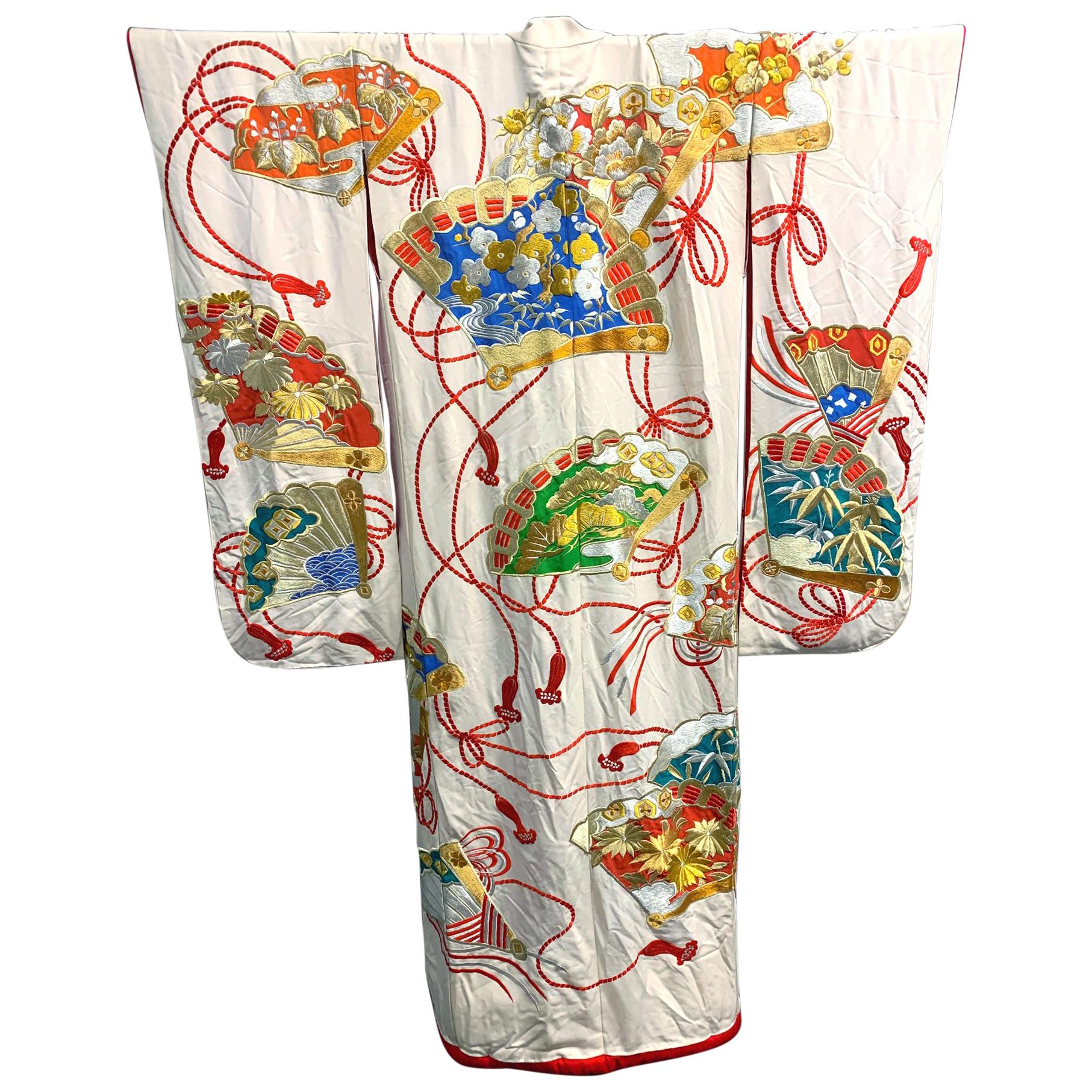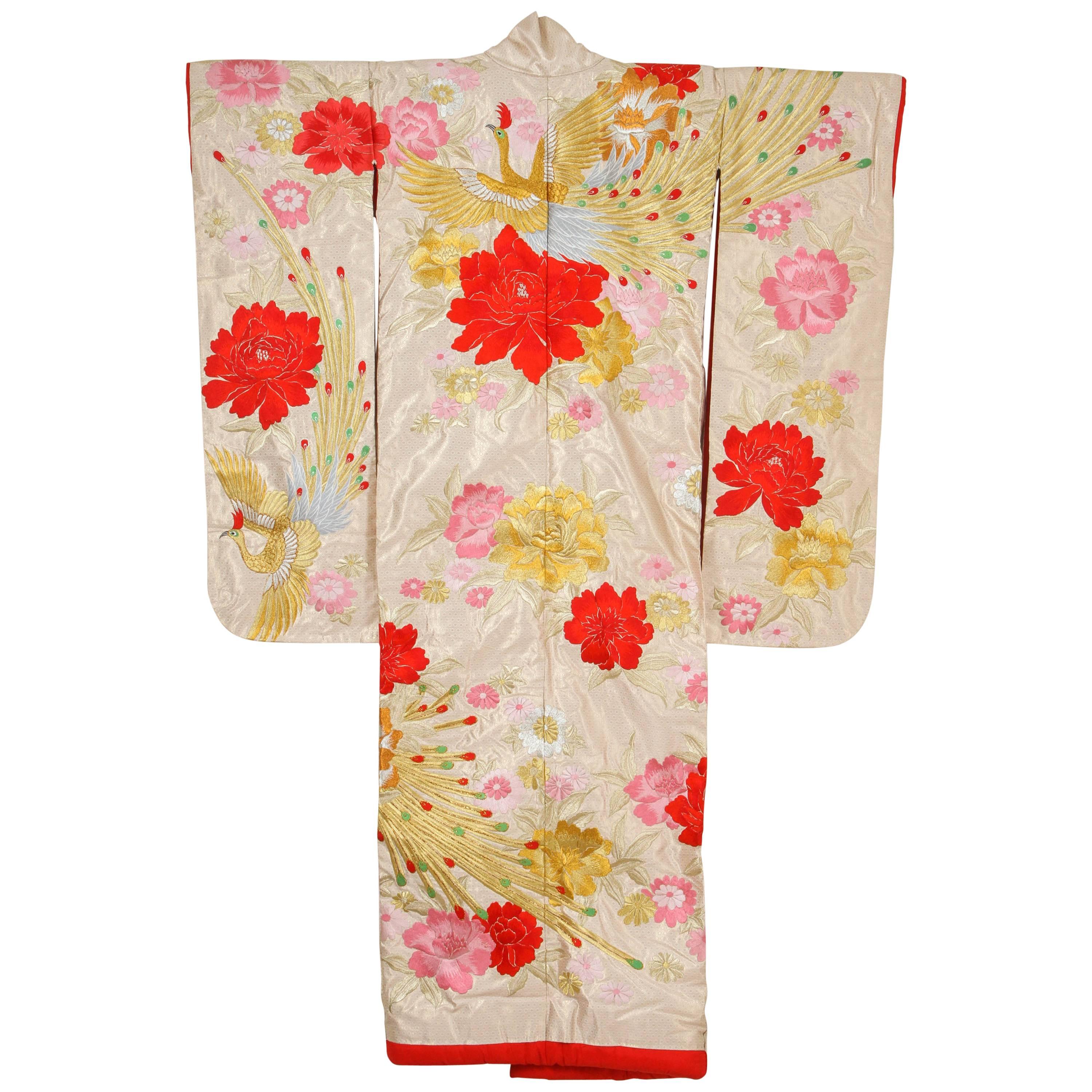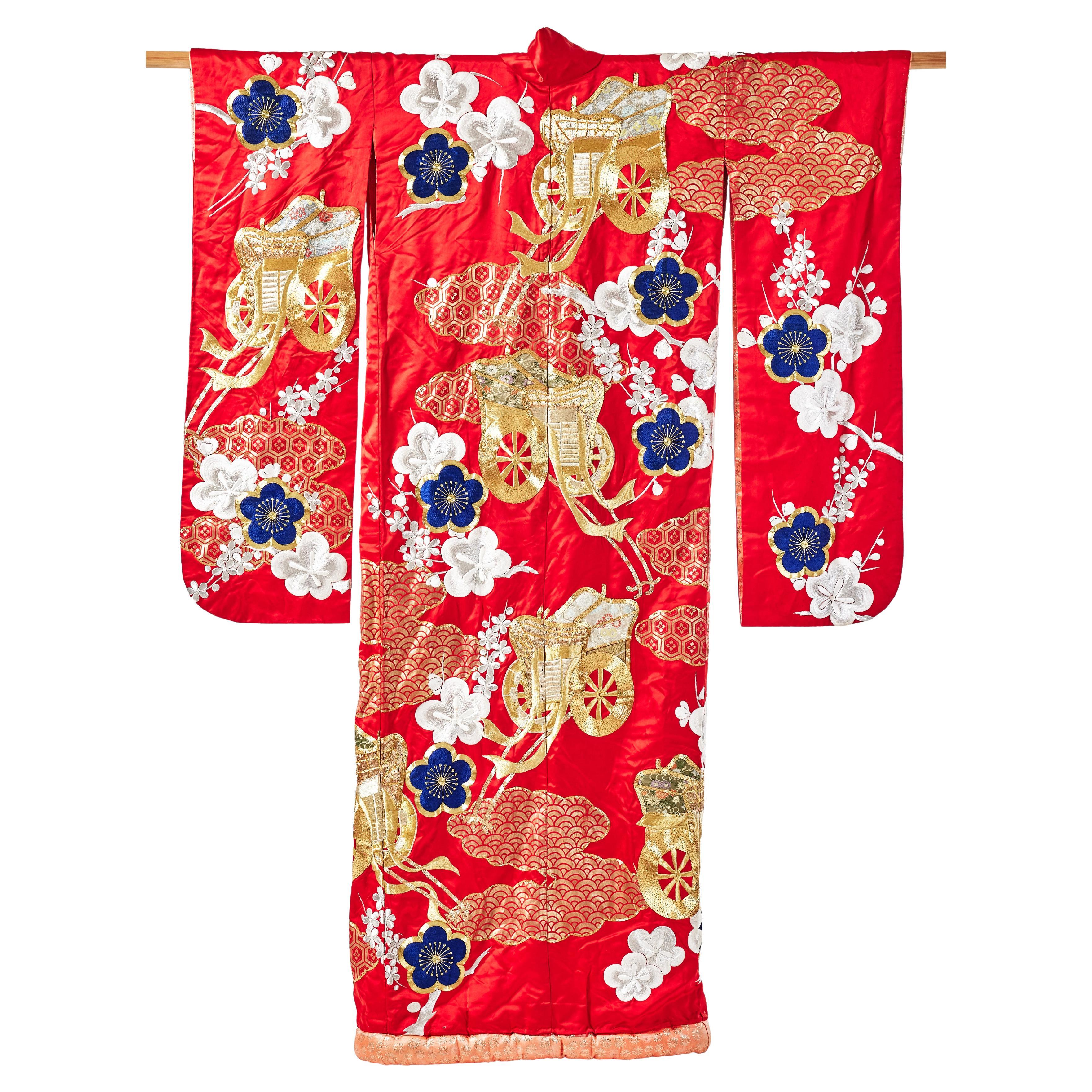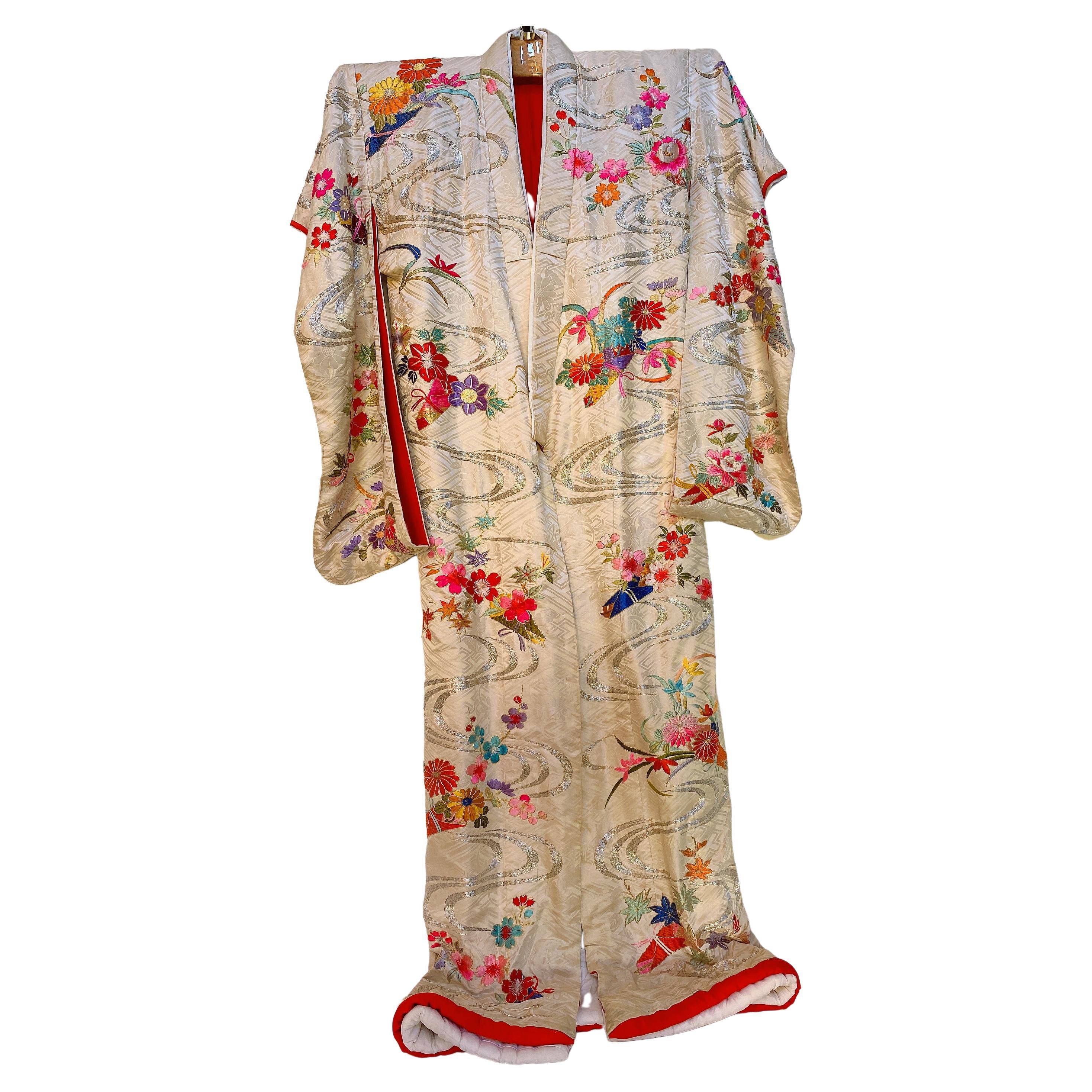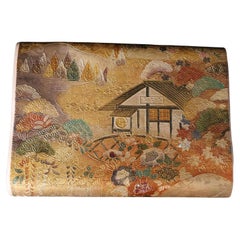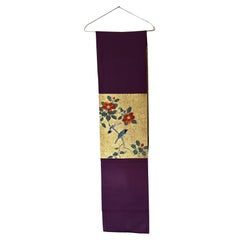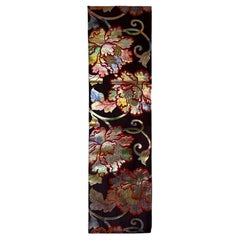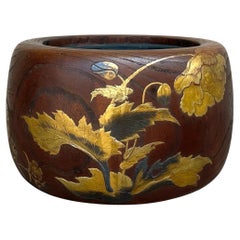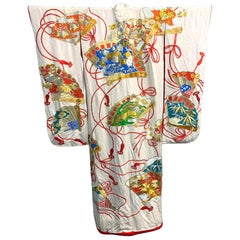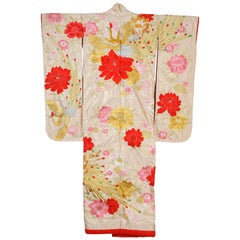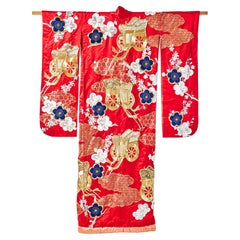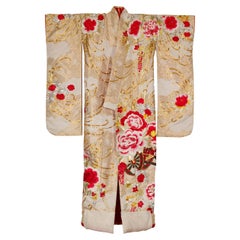Items Similar to Japanese Maru Obi with Gold Embroidered Dragons – Silk Brocade, Taisho to Showa
Want more images or videos?
Request additional images or videos from the seller
1 of 12
Japanese Maru Obi with Gold Embroidered Dragons – Silk Brocade, Taisho to Showa
$1,050
£806.68
€926.86
CA$1,476.96
A$1,659.29
CHF 866.98
MX$20,252.45
NOK 11,008.15
SEK 10,361.86
DKK 6,916.59
About the Item
A magnificent example of Japanese textile artistry, this vintage maru obi dates from the Taisho to early Showa period (circa 1920–1950). Woven in luxurious silk, it features a richly detailed brocade design with mythological dragons encircled by flames and stylized clouds—symbols of strength, protection, and imperial authority in Japanese culture.
The opulent gold and beige ground is accented with bold tones of red, green, black, and purple, showcasing intricate weaving techniques and vibrant color contrasts. Hexagonal panels with floral motifs in gold and black add structure and visual rhythm to the piece. Measuring 341 cm in length and 32 cm in width, this maru obi was traditionally worn for formal kimono occasions and would have wrapped fully around the waist.
Today, it makes a powerful statement as a display piece—whether mounted as wall art or draped as a textile sculpture—highlighting the beauty and craftsmanship of early 20th-century Japanese weaving.
Origin: Japan
Period: Taisho to early Showa (1920–1950)
Material: Silk brocade
Technique: Handwoven, gold thread embroidery
Design Motif: Dragons, clouds, floral hexagons
Dimensions: 341 x 32 cm
Condition: Very good vintage condition; minor signs of age appropriate to its time
- Dimensions:Height: 12.6 in (32 cm)Width: 134.26 in (341 cm)Depth: 0.04 in (1 mm)
- Style:Showa (Of the Period)
- Materials and Techniques:
- Place of Origin:
- Period:
- Date of Manufacture:1920-1960
- Condition:Minor losses.
- Seller Location:Fukuoka, JP
- Reference Number:1stDibs: LU10055245483822
About the Seller
No Reviews Yet
Vetted Professional Seller
Every seller passes strict standards for authenticity and reliability
Established in 2023
1stDibs seller since 2024
9 sales on 1stDibs
Typical response time: 13 hours
- ShippingRetrieving quote...Shipping from: Fukuoka, Japan
- Return Policy
Authenticity Guarantee
In the unlikely event there’s an issue with an item’s authenticity, contact us within 1 year for a full refund. DetailsMoney-Back Guarantee
If your item is not as described, is damaged in transit, or does not arrive, contact us within 7 days for a full refund. Details24-Hour Cancellation
You have a 24-hour grace period in which to reconsider your purchase, with no questions asked.Vetted Professional Sellers
Our world-class sellers must adhere to strict standards for service and quality, maintaining the integrity of our listings.Price-Match Guarantee
If you find that a seller listed the same item for a lower price elsewhere, we’ll match it.Trusted Global Delivery
Our best-in-class carrier network provides specialized shipping options worldwide, including custom delivery.More From This Seller
View AllJapanese Obi with Landscape and Pavilion Motif – wall decoration, table runner
Located in Fukuoka, JP
A stunning Japanese obi textile from the Shōwa period, masterfully woven from silk with exquisite raden (mother-of-pearl inlay) detailing. This formal maru obi features a rich and in...
Category
20th Century Japanese Showa Textiles
Materials
Silk
Antique Japanese Obi Textile Panel with Birds and Camellia Flowers, Meiji Period
Located in Fukuoka, JP
A magnificent antique Japanese silk obi fragment from the Meiji period (1868–1912), showcasing exceptional hand embroidery and gold leaf overlay.
This refined textile features a pai...
Category
Antique 19th Century Japanese Meiji Textiles
Materials
Silk
Japanese Silk Obi/Table Runner/Wall decoration with Peony Motif
Located in Fukuoka, JP
apanese Silk Obi Table Runner with Peony Motif
Japan, 20th century
Dimensions: 440 × 32 cm
This luxurious silk obi has been repurposed into an elegant table runner. Woven with shimm...
Category
20th Century Japanese Showa Textiles
Materials
Silk
Exceptional Japanese Lacquered Hibachi with Poppy Flowers in Gold and Silver Mak
Located in Fukuoka, JP
This magnificent hibachi (charcoal brazier), likely custom-made to order, exemplifies the pinnacle of Japanese lacquer artistry of the 19th century. Carved from solid wood with a ric...
Category
Antique 19th Century Japanese Edo Lacquer
Materials
Copper
Pair of Japanese Hibachi with Inlaid Bamboo Motif
Located in Fukuoka, JP
A beautifully matched pair of Japanese hibachi (traditional fire bowls) from the Meiji period (1868–1912), showcasing exceptional craftsmanship and refined aesthetics. Each vessel is...
Category
Early 20th Century Japanese Taisho Lacquer
Materials
Wood
Set of Edo Period Samurai Armor Box Covers (Yoroi Bitsu Covers) with Gold Family
Located in Fukuoka, JP
Set of Edo Period Samurai Armor Box Covers (Yoroi Bitsu Covers) with Gold Family Crests
Japan, 18th century (Edo period)
Dimensions: Approx. 40 × 40 cm, H 53 cm
An extremely rare se...
Category
Antique 18th Century Japanese Edo Arms, Armor and Weapons
Materials
Leather
You May Also Like
Exceptional Embroidered Vintage Japanese Ceremonial Kimono
Located in Atlanta, GA
A visually striking vintage Uchikake Wedding Kimono/Robe for ceremonial occasion, circa 1930s-1950s in the Oriental Art Deco style. The bridal garment...
Category
20th Century Japanese Japonisme Textiles
Materials
Cotton, Silk
Vintage Japanese Ceremonial Kimono Gold Brocade with Flying Cranes
Located in North Hollywood, CA
A vintage Mid-Century ivory color silk brocade collectable Japanese ceremonial kimono. One of a kind hand crafted.
Fabulous museum quality ceremonial piece in pure silk with intricat...
Category
20th Century Japanese Japonisme Textiles
Materials
Silk
Silk Brocade Japanese Kimono Ceremonial Gown
Located in Vienna, AT
Japanese kimono, richly decorated with polychrome embroideries with silk and metallic threading, bright red silk set, embroidered decoration and appliqué, motif of flowers and horses...
Category
Vintage 1920s Japanese Showa Textiles
Materials
Silk
Vintage Silk Kimono with Gold, Silver and Red Embroidery
Located in Yonkers, NY
A vintage Japanese Showa era handcrafted silk brocade woman's wedding kimono circa 1940 with intricate hand-embroidered details depicting large flowers and a cart. Steeped in cultura...
Category
Mid-20th Century Japanese Showa Textiles
Materials
Brocade, Silk
Silk Brocade Japanese Kimono Ceremonial Gown
Located in Vienna, AT
Japanese kimono, richly decorated with polychrome embroideries with silk and metallic threading, featuring a motif of flowering prunus to a cream-white ground. Lined with bright red ...
Category
Vintage 1920s Japanese Showa Textiles
Materials
Silk
Rare Spectacular Hand-Embroidered Silk Japanese Kimono
Located in Brea, CA
This highly collectable spectacular rare kimono has detailed hand-embroidery throughout accented . This ceremonial Japanese kimono is hand sewn and hand-quilted throughout.
Category
Early 20th Century Chinese Chinese Export Antiquities
Materials
Silk
More Ways To Browse
Embroidery Design
Textile Art Weaving
Silk Gold Thread
Silks With Gold Threads
Japanese Dragon
Japanese Weaving
Vintage Dragon Art
Imperial Measure
Dragon Silk
Japanese Embroidery
Vintage Silk Brocade
Gold Thread Embroidery
Japanese Embroidered
Gold Kimono
Silk Gold Thread Embroidery
Vintage Silk Embroidery Thread
Asian Dragon Sculpture
Kimono Obi
